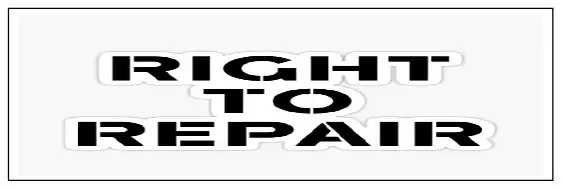Right to Repair: A New Emerging Consumer Right

The Centennial Light has been in use since 1901 and has nearly never been turned off, making it the world's longest-lasting light bulb. This light bulb has not been switched off for the last 120 years. If a 19th-century light bulb can last a century, why can't 21st-century electronic devices? Why are products replaced rather than repaired? Why are we buying more and not amending old products? Why are we buying the same product with different specifications again and again? Is this behavior the new normal in the modern world or is it well crafted? Design and patterns are created by companies to maximize their profits.
Companies have led us to believe that the products we will purchase will become outdated soon. For this, companies offer new updates to the old model which purposively increase some specifications or simply deny the right to repair. Some buyers want the new version, but some buyers want to continue with the old version. But as the old product is slow, ineffective, and not easily repairable, then they are left with no choice but to switch to the new one. This is how consumer rights to choice, specifically the right to repair, are overlooked.
According to studies, when a product fails, people prefer to replace it rather than repair it. Customers' options are limited as a result of these restrictions. This led to the Global Moment of Right to Repair, where customers across states came together and advocated for their rights. The impact of the moment resulted in a change in the policy of the Apple Company Program as now they have started repairing the batteries, screens, and cameras of their products.
If we define "right to repair" as a concept that allows consumers the right to repair services on their own devices without any legal or pedagogical restrictions, the notion behind this claim is to make products more effective, cheaper, and more durable. The Right to Repair can be applied to all types of products like electronic devices, automobile products, etc. Using this method, the manufacturer will be bound to provide product self-repairs spare parts that can repair products and guides or manuals for repairs.
The right-to-repair moment started in 2012 in the USA for the automobile industry. Later in 2013, this moment extended to the electronic industry. In 2017, Apple recognized and accepted the right to repair as a legal right. Now, these rights have been granted to customers across the USA and the UK. However, in India, the scenario is a bit different. Companies invoke the below-listed provisions to stay away from the right to repair.
1) Trademark Act, section 29, clause 1 restricts the customer from right to Repairs as they are Commercial in nature and may infringe trade mark of the company.
2) Section 140 of the Patent Act protects manufacturers by allowing repair services to be performed only through a company.
3) End user license agreements are made in such a manner that they impose restrictions on consumers, like restrictions on transfer, restrictions on warranty, and restrictions on reverse engineering.
The Competitive Commission of India recently decried such practices as anti-competitive in nature as they violate customer rights. In the Sanjeev Nirvani Case, it was held by the Apex Court that companies are liable to keep spare parts even after the expiration of the warranty period. Through these precedents, surely very soon in India, the right to repair will be recognized. Once the right to repair is shifted from the ethical right domain to the legal right domain, things will change A Right to Repair is required as it will keep big companies in check and make them accountable. It will reduce the cost of repairs, "said customers." E-waste will be reduced, and environmentally friendly development will be promoted. New employment opportunities will increase in the repairing market.
About the Authors Of This Article
Ankit Tiwari
Hi, I am an Indian lawyer with over three years' of experience as a legal consultant for various
businesses and commercial organizations. In addition to this, I have authored numerous
publications and am an expert in legal content writing, proofreading, and editing. I am the
author of the books " Cyber Law and Technology" and " Socio-Legal Dimensions of Gender,"
published by Singhal's Law Publication. Multiple articles, book reviews, case summaries, and
research papers that I have written have been published on several websites and in journals.
Vishwanath Mishra
Hi, I am a practicing advocate in Jharkhand High Court. Mortar Vehicle Claims, Cheque
Bouncing Cases and Rent matters are my areas of expertise. I am also pursuing my LLM from
Institute of Leal Studies; Ranchi affiliated to University Morabadi Campus, Ranchi. ‘A Critical
Analysis of Uniform Civil Code in India’ is my topic of dissertation.
DISCLAIMER
This article is just for information purposes, we do not claim any authenticity regarding the content of this post. If you find any content which is offensive for any reason, you are free to contact and inform us at any moment. We will consider requests to remove the content but we are not obligated to or so or to respond to you directly. Legal Bonanza does not approve, endorse, or adopt any content submitted by the others, and assumes no liability whatsoever. Authors of submitted articles will indemnify and hold harmless Legal Bonanza against all third-party claims, demands, and actions brought against Legal Bonanza, which arise from or relates to the content submitted by authors.
